In this post we discuss Velocity Made Good or VMG. Many newer sailors are not familiar with this important concept, so we’ll discuss the definition and show some examples. Then we’ll discuss how to use the concept of target boat speed to maximize your VMG.
View the video or read through the text below.
Definition
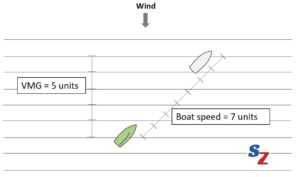
Velocity made good is the speed at which you are making progress directly upwind or directly downwind.
Here’s an example with some made up numbers. The blue boat sails upwind on a close hauled course at about 45 degrees to the wind. The boat travels 7 units of distance in the time period, so we’ll say it’s boat speed was 7 units. The scale on the left shows that the boat traveled 5 units of distance upwind in the same time period. So, the boat’s VMG in this case is 5 units.
Examples
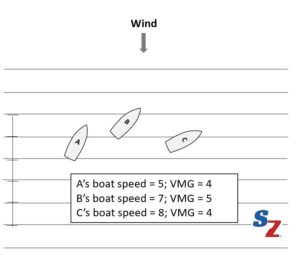
To show the importance of VMG, let’s compare the boat in the graphic above (Boat B in the graphic to the right) to two other boats sailing upwind.
Another boat (C) eases her sheets. C is reaching and sails faster, but at a lower heading than B. Her boat speed is 8 units in the same time period. She advanced 4 units upwind, so her VMG is 4 units.
Still another boat (A) decides to sail closer to the wind, so she sheets in tightly and heads up. She is pinching and her speed is 5 units. Her VMG is also 4 units.
These are made up numbers, but they illustrate that VMG depends on your boat speed and your heading.
Why is Velocity Made Good Important?
VMG measures how fast you are making progress directly upwind (or downwind). Therefore, if you’re sailing windward/leeward courses, the boat that has the highest average VMG wins the race. It’s that simple. If this puzzles you, go back and review our post on ladder rungs.
If the course is a reach, then VMG doesn’t matter – it’s straight line boat speed that matters.
Realize that it’s your average VMG that matters. You won’t always sail at your best VMG: sometimes you will pinch or foot, or even sail on a header to get to a favorable shift or puff. But if you find that favorable shift or puff, it will greatly increase your VMG.
Top sailors don’t spend a lot of time talking about VMG or trying to measure. The concept is important, but measuring it is not very important. To measure it, you need instruments that sense the actual wind speed and direction and track your progress upwind or downwind. Big keel boats have these instruments, but even for them, VMG changes so rapidly that it’s not useful.
Instead, we use other indicators to sail at max VMG. We’ll talk about these more below.
Maximize your VMG with Target Boat Speeds
One way to think about VMG is a concept called target boat speed. Keel boats use instruments to maximize VMG by sailing at target boat speeds.
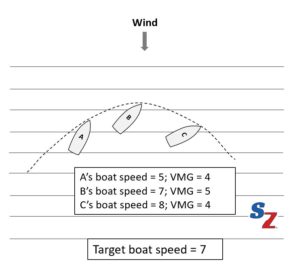
To understand target boat speed, let’s review our previous examples.
- Boat A had a boat speed of 5 and a VMG of 4.
- Boat B sailed at 45 degrees to the wind and had a boat speed of 7 and a VMG of 5.
- Boat C footed off and had a boat speed of 8 and a VMG of 4.
So, Boat B had the maximum VMG of these three boats. Let’s assume that B chose the very best combination of speed and sailing angle.
VMG curve
In the drawing above, notice the curve (dotted line) showing how far upwind boats would get if they sailed at different angles upwind. Assuming they were all trimmed up properly for their chosen headings, they would end up somewhere on the curve. This curve shows that a boat speed of 7 maximizes your VMG in this case. So, for this wind and these fictional boats, we would say that the target boat speed is 7.
So, the target boat speed is the speed at which your velocity made good is maximized for a given wind speed, assuming proper trim. If your boat is sailing above the target speed, like C, you’re footing. If your boat is sailing below the target speed, like A, you’re pinching.
Racing keelboats have instruments with target speeds programmed into them for each wind speed. On these boats, the helmsman and crew adjust the boat’s heading and trim until they match the target.
Target Speed and Puff Response – Upwind
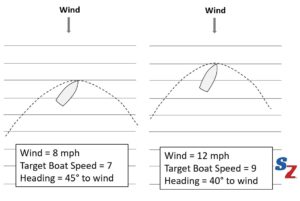
When sailing upwind, many sailors have trouble getting the most out of the boat in a puff. The target speed concept can help you understand the best way to respond and maximize your VMG.
First, realize that target speed and heading angle are different for each wind speed. In our first example the target speed was 7. Let’s assume that occurred with the true wind at 8 mph and the heading of 45 degrees to the true wind.
If the wind increases to 12 mph, the target speed and heading will change. Let’s say that it changes to a target speed of 9 and a heading of 40 degrees.
Puff Response
If you’re sailing in an 8 mph wind and a puff of 12 mph comes along that lasts several seconds, how should respond to maximize your VMG? Should you head up to the 40 degree angle first? Or worry about the target speed?
If you think about target speeds, you will realize that your target boat speed increases when the puff hits, and so you must gain speed to get to the new target. If you head up first, you won’t build speed rapidly. You might even slow down if you head up too quickly.
Instead, you need to focus on getting to the new target speed as quickly as possible. Increase your speed by easing the sail and holding your heading steady or feathering up just a bit. During this speed building time, you’re sailing below the new angle of 40 degrees.
Once you build speed, you can head up fully to the new 40 degree angle.
Lull Response
Next think about the proper lull response. Let’s reverse the above situation. You’re sailing in 12 mph breeze at your target of 9, and along comes a lull to a wind of 8 mph. How should you react?
Hopefully, you can see that your new target speed is lower. To get to that new target quickly, hold your heading, even though you are sailing too high for the 8 mph wind. This will bleed off your speed quickly, and also let you make more progress upwind for a short time. Once your speed is down to target, you can bear off to the lower heading.
Maximizing VMG Downwind
just like upwind, there is a target boat speed and sailing angle that maximizes your velocity made good downwind.
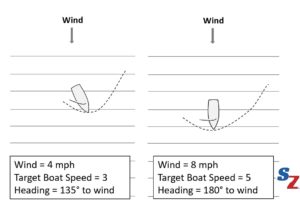
In light air, most boats sail very slowly if they head dead downwind. To compensate, we head up to gain speed. The extra speed more than compensates for the extra distance we sail. Using made up numbers, if the wind were 4 mph, we might sail at a heading of 135 degrees to the wind to build to a speed of 3 mph. Boats that sail low might point closer to the mark, but make less progress. Boats that sail higher will go faster, but will also make less progress. This relationship is indicated by the dotted curves.
In heavier air, we can sail lower and still maintain higher speeds. In this example, if the wind is 8 mph, we might be able to sail dead downwind at 5 mph, maximizing our VMG. Thus, the dotted curve for 8 mph show a max VMG when heading straight downwind.
This is one of the reasons for the downwind advice to “sail up in the lulls and down in the puffs.” Following this advice blindly is not the best way to maximize VMG.
Puff and Lull Response Downwind
If you’re reaching up a little to get more speed in light air, and a puff comes along, should you head down immediately?
Just like the upwind response, the answer is to adjust your trim and hold your heading or feather down only slightly to build to your target speed as quickly as possible first. Then head down.
For a lull, bleed your speed while gaining distance downwind, before you head up. This might only take a few seconds.
Notes About Target Speed
Don’t worry about the math and geometry. It’s the concept, that there is a best speed and associated heading angle to maximize your VMG. The sailors that keep their boats at or near target speed will make the most upwind or downwind progress.
Cues
Since we don’t have instruments, we need other cues to tell us when we’re at target speed. Here are some:
- The target speed concept is based on sailing your boat as fast as possible for the heading – that means proper sail trim, angle of heel, and hiking. If you’re not doing that, then by definition you’re not sailing at target speed.
- Once you learn how to responds to puffs and lulls properly, you will feel the difference and will want to get that feel every time.
- You can always tell if you’re gaining on other boats by comparing ladder rungs. See our video on ladder rungs for how to do this.
“Fudging” on Target Speed
Of course, there are situations when you may not want to sail strictly at target speed. These include the following:
- Tactical or strategic positioning situations
- Waves, where you might want to foot a bit to power through
- Cases in which your boat’s speed limits (such as hull speed) and performance characteristics blur the target speed concept. We’ll discuss this idea in another post.
VMG (Velocity Made Good) – eye-catching video from Oracle Team USA
VMG to Wind Calculator – just for fun from L-36.com

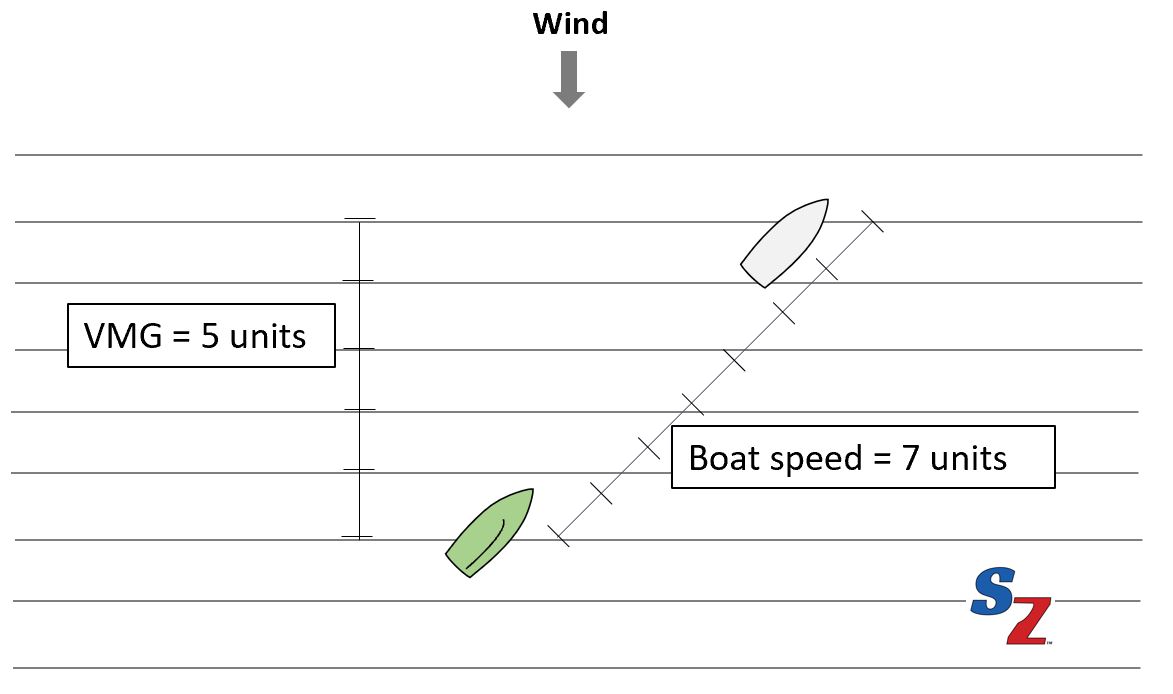
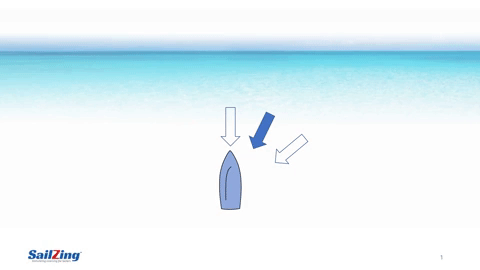
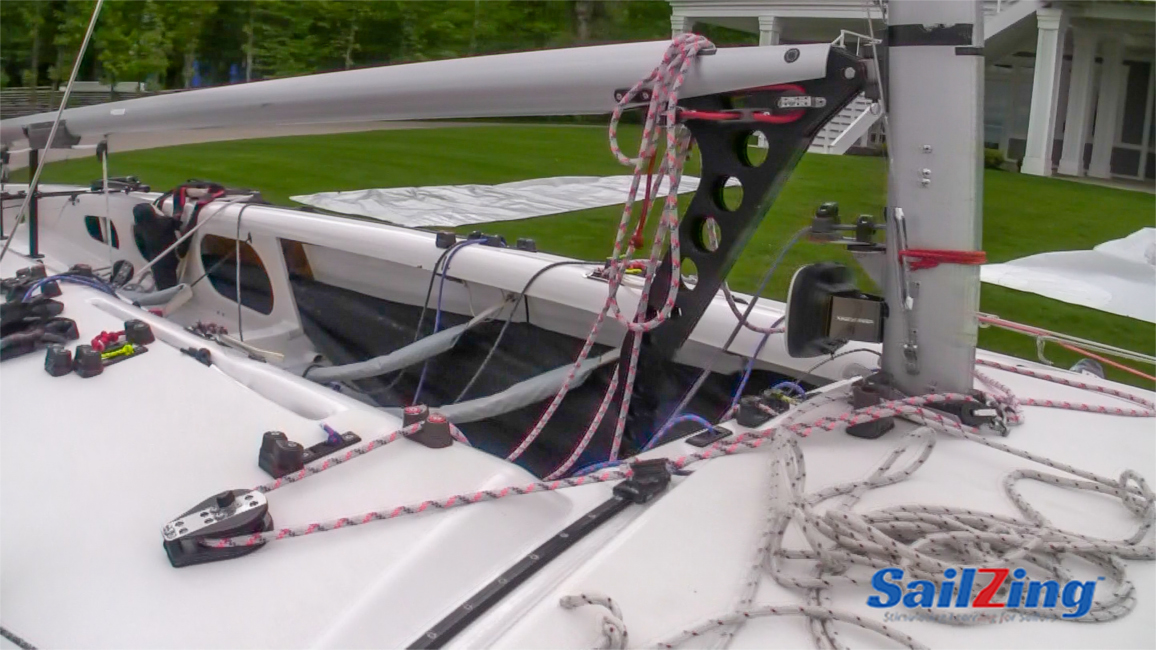

This was a great article/commentary. I have often heard the term but never really understood it until now. Thanks a lot. Adrian
Thanks for the feedback! Let us know what other content you’d like to see.
Bin durch Zufall auf Eure tolle ! Seite(n) gestoßen; was ich bis jetzt gelesen habe ist klasse – ich hoffe, ich kann meine Jungs jetzt besser überzeugen ! – is german ok here or are all you guys US and others ?
Welcome Klaus! Deutsch is certainly welcome! Happy to have you share any sailing tips that you have. -Rob